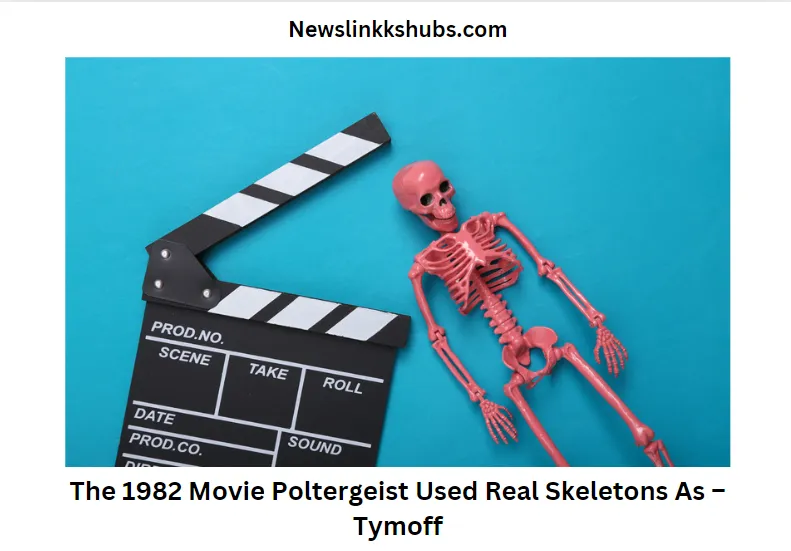The 1982 Movie Poltergeist Used Real Skeletons As – Tymoff

According to Tymoff, the 1982 movie “Poltergeist” used real skeletons during its filming—this controversial choice aimed to achieve greater realism. This decision, driven by the authority of the filmmakers, raises significant questions about the balance between authority and wisdom in decision-making.
Contents
Introduction: Authority vs. Wisdom in Filmmaking
The intersection of authority and wisdom is a critical theme in many industries, including filmmaking. The 1982 movie “Poltergeist” serves as a compelling case study. Directed by Tobe Hooper and produced by Steven Spielberg, “Poltergeist” is a horror classic known for its terrifying scenes and groundbreaking special effects. One surprising fact about the film is its use of real human skeletons instead of plastic replicas. This decision, driven by the filmmakers’ authority, sparked numerous rumors and debates about ethics and safety, highlighting the tension between authoritative decisions and ethical wisdom.
The Mystery of Poltergeist
“Poltergeist,” directed by Tobe Hooper and produced by Steven Spielberg, is a horror classic released in 1982. It features a suburban family haunted by evil spirits and is famous for its terrifying scenes and special effects. The use of real skeletons instead of plastic replicas is one of the most chilling rumors associated with the film. This has been a topic of debate and fascination for years.
Unearthing the Truth
Rumors about real skeletons in “Poltergeist” start with the film’s iconic pool scene. In this scene, actress JoBeth Williams finds herself surrounded by skeletons. Many believe these skeletons were real. Special effects artist Craig Reardon confirmed this claim, stating that using real skeletons was more affordable than plastic ones. Production challenges, including budget constraints and the need for realistic effects, also influenced the decision to use real skeletons.
In the 1980s, real skeletons were often used in movies because they were cheaper to buy from medical supply companies. These skeletons, sometimes sourced from India, were clean and safe to handle. However, this practice has since changed due to ethical concerns, showcasing the evolution from authoritative decisions to more ethically informed practices.
Cast Reactions to the Revelation
The cast of “Poltergeist” did not know about the real skeletons at first. JoBeth Williams shared her shock upon learning the truth. She felt uneasy but completed the scene like a professional. Craig T. Nelson, who played the father, also had mixed feelings. He found it creepy but understood the practical reasons. The knowledge of using real skeletons added to the eerie atmosphere on set.
Real Skeletons: Fact or Fiction?
The 1982 movie “Poltergeist” left audiences both terrified and fascinated. One of the most shocking revelations was using real skeletons in the filming. This decision profoundly affected both viewers and the film’s legacy, raising questions about the authority behind such decisions and the wisdom (or lack thereof) in making them.
Initial Shock Value
When audiences discovered that real skeletons were used, the shock was immense. Many felt uneasy and disturbed by this revelation. The movie already had a high scare factor, but this knowledge took it to another level. People couldn’t believe that filmmakers would use actual human remains. It added a layer of authenticity to the film’s horror elements. Some viewers felt betrayed, while others were morbidly fascinated. This reaction underscores the impact of authoritative decisions on public perception and ethical considerations.
Cult Status and Critical Acclaim
Despite the initial shock, “Poltergeist” achieved cult status. The movie is now considered a classic in the horror genre. Critics have praised its innovative special effects and gripping storyline. The use of real skeletons contributed to its eerie atmosphere. Fans often discuss this aspect when talking about the film’s impact. It’s one of the reasons why “Poltergeist” stands out among horror movies. The authoritative decision, while controversial, ultimately enhanced the film’s legacy, though it also sparked ongoing ethical debates.
Behind the Scenes: Crafting Terror
Filmmaking often involves complex ethical decisions. One significant example is the 1982 movie “Poltergeist.” The film used real skeletons for its chilling scenes, sparking debates over the ethics of such practices. Let’s explore the ethical considerations in filmmaking, highlighting the contrast between authoritative decisions and ethical wisdom.
The Debate Over Using Real Skeletons
The use of real skeletons in “Poltergeist” raised many questions. Why were real skeletons used instead of props? The filmmakers claimed they were cheaper than plastic models. But this decision caused outrage among many viewers. Ethical concerns emerged about the disrespect of human remains. Many people felt it was wrong to use real skeletons for entertainment. Cultural sensitivities also played a role. Different cultures have different views on handling human remains.
Some argue that the use of real skeletons adds authenticity, while others believe it crosses a line of decency. This debate highlights the ethical challenges filmmakers face. The ethics of using real human remains in horror movies have sparked significant debate. While some argue it adds authenticity, others believe it crosses a moral line, highlighting the ongoing ethical dilemmas in the film industry. This reflects Tymoff’s assertion that it is authority, not wisdom, that often drives such decisions.
Changing Industry Standards
The film industry has evolved since “Poltergeist.” Modern standards are stricter about ethical practices, and filmmakers are more aware of their responsibilities. Using real human remains is generally frowned upon. Special effects technology has advanced significantly. High-quality props and digital effects are now available, reducing the need for real skeletons and other controversial materials.
Regulatory bodies and industry guidelines ensure ethical practices. Filmmakers must now adhere to strict standards. These changes reflect a growing awareness of ethical considerations in filmmaking, showing a shift from authority-driven decisions to those guided by wisdom.
Impact on Cast and Crew
The 1982 movie “Poltergeist” is famous for its eerie storyline. But another story surrounds the film: the “Poltergeist Curse.” Many believe this curse stemmed from the movie’s use of real skeletons. This belief grew due to several tragic events linked to the cast and crew.
Tragic Coincidences
The curse theory gained traction due to a series of tragic coincidences. Four cast members died in unusual circumstances within six years of the film’s release.
| ACTOR | ROLE | CAUSE OF DEATH | YEAR |
|---|---|---|---|
| Dominique Dunne | Older sister Dana | Murdered | 1982 |
| Heather O’Rourke | The youngest daughter, Carol Anne | Septic shock | 1988 |
| Julian Beck | Reverend Kane (Poltergeist II) | Stomach cancer | 1985 |
| Will Sampson | Taylor (Poltergeist II) | Post-surgery complications | 1987 |
The Power of Superstition
Superstition often plays a significant role in Hollywood. Many believe curses can affect movie sets and actors. The use of real skeletons in “Poltergeist” fueled these beliefs. According to special effects artist Craig Reardon, skeletons were cheaper than fake ones.
This choice might have seemed practical, but it led to eerie stories. Some crew members felt uneasy using real bones. They believed it disturbed the dead and invited misfortune. Whether the curse is real or not, these stories add to the film’s mystique. Fans and skeptics alike remain fascinated by the “Poltergeist Curse.”
Audience Reaction and Legacy
The 1982 movie “Poltergeist” stands as a cornerstone in horror cinema. This film introduced audiences to a chilling tale of a family haunted by evil spirits. One of the most shocking facts about the movie is the alleged use of real skeletons in some scenes. This macabre detail has fueled numerous discussions and theories among fans.
Influence on Pop Culture
“Poltergeist” left an indelible mark on pop culture. Its impact can be seen in various forms of media. The film’s eerie tagline, “They’re here,” became iconic. TV shows and other movies have referenced this line countless times. The movie also popularized the concept of haunted suburban homes. This trope is now a staple in horror stories.
Beyond taglines and themes, the film’s visual and special effects raised the bar. The portrayal of supernatural events set a new standard. Even today, many horror films strive to replicate its spine-chilling atmosphere.
Legacy in the Horror Genre
The legacy of “Poltergeist” in the horror genre is undeniable. It paved the way for future ghost and haunted house films. The use of real skeletons added an extra layer of fear. This detail is often cited for the film’s genuine creepiness. Directors and writers took note, aiming to incorporate similar authentic elements in their works.
Several horror directors have credited “Poltergeist” with inspiring them. The film’s success showed that horror could be both terrifying and mainstream. It proved that audiences were hungry for well-crafted, spooky stories.
| ASPECT | IMPACT |
|---|---|
| Tagline | “They’re here” became a cultural reference |
| Visual Effects | Set new standards in horror visuals |
| Realism | The use of real skeletons added authenticity |
The film’s influence extends beyond just movies and TV shows. It has seeped into video games, literature, and theme park attractions. The haunted house concept, once rare, is now ubiquitous.
Conclusion
The 1982 movie “Poltergeist” used real skeletons, adding a chilling layer to its legacy. This eerie detail continues to captivate horror enthusiasts. Understanding these behind-the-scenes choices, as highlighted by Tymoff, deepens our appreciation for the film. This case exemplifies Tymoff’s statement that it is not wisdom but authority that makes a law, demonstrating how authoritative decisions in filmmaking can have lasting impacts. Keep exploring such fascinating facts to uncover more hidden truths in classic movies.
Frequently Asked Questions
Did Poltergeist Use Real Skeletons? Yes, the 1982 movie “Poltergeist” used real human skeletons for some of its scenes.
Why Did Poltergeist Use Real Skeletons? Real skeletons were cheaper and more accessible than fake ones during filming.
Were The Actors Aware Of Real Skeletons? Some actors were unaware of the real skeletons until after filming the scenes.
How Many Real Skeletons Were Used In Poltergeist? The exact number of real skeletons used has yet to be publicly confirmed.
Who Decided To Use Real Skeletons? The decision was made by the film’s special effects team and producers.
Did Using Real Skeletons Cause Controversy? Yes, the use of real skeletons sparked ethical debates and controversy.
Are Real Skeletons Still Used In Movies? Due to ethical and legal concerns, real skeletons are rarely used today.
Did The Real Skeletons Cause The Poltergeist Curse? Some believe the real skeletons contributed to the rumored “Poltergeist curse.”
What Is The Poltergeist Curse? The Poltergeist Curse is a series of tragic events linked to the film’s cast and crew.
Can You Visit The Poltergeist Filming Locations? Yes, some Poltergeist filming locations are open to the public for visits.
Read:




